Seismotectonics, Geomorphology and Paleoseismology of the Doroud Fault, a Source of Seismic Hazard in Zagros
Abstract
1. Introduction
2. Tectonic Setting and Seismicity
3. Method and Data
4. Geomorphology and Slip Rate of the Doroud Fault
5. Palaeoseismic Trenching along the Doroud Fault
6. Discussion
7. Conclusions
Author Contributions
Funding
Institutional Review Board Statement
Informed Consent Statement
Data Availability Statement
Acknowledgments
Conflicts of Interest
References
- Nelson, C.; Gutiérrez Pastor, J.; Goldfinger, C.; Escutia, C. Great earthquakes along the Western United States continental margin: Implications for hazards, stratigraphy and turbidite lithology. Nat. Hazards Earth Syst. Sci. 2012, 12, 3191–3208. [Google Scholar] [CrossRef]
- Yeats, R.S.; Sieh, K.; Allen, C.R. The Geology of Earthquakes; Oxford University Press: Oxford, UK, 1997. [Google Scholar]
- Zhongyuan, Y.; Peizhen, Z.; Wei, M.; Qinghai, W.; Limei, W.; Bin, Z.; Shuang, L.; Jian, K. Late Cenozoic deformation of the Da’an-Dedu Fault Zone and its implications for the earthquake activities in the Songliao basin, NE China. J. Asian Earth Sci. 2015, 107, 83–95. [Google Scholar] [CrossRef]
- Yin, N.; Wang, C.; Deng, M.; Lan, W. Active tectonics, paleoseismology and seismic hazards of the piedmont Xizhoushan fault zone in the Shanxi graben system, North China Block. J. Asian Earth Sci. 2021, 205, 104590. [Google Scholar]
- Derakhshani, R.; Eslami, S. A new viewpoint for seismotectonic zoning. Am. J. Environ. Sci. 2011, 7, 212–218. [Google Scholar] [CrossRef]
- Rahbar, R.; Shafiei Bafti, S.; Derakhshani, R. Investigation of the tectonic activity of Bazargan Mountain in Iran. Sustain. Dev. Mt. Territ. 2017, 9, 380–386. [Google Scholar] [CrossRef]
- Kermani, A.F.; Derakhshani, R.; Bafti, S.S. Data on morphotectonic indices of Dashtekhak district, Iran. Data Brief 2017, 14, 782–788. [Google Scholar] [CrossRef]
- Wechsler, N.; Rockwell, T.K.; Klinger, Y.; Štěpančíková, P.; Kanari, M.; Marco, S.; Agnon, A. A paleoseismic record of earthquakes for the Dead Sea transform fault between the first and seventh centuries CE: Nonperiodic behavior of a plate boundary fault. Bull. Seismol. Soc. Am. 2014, 104, 1329–1347. [Google Scholar] [CrossRef]
- Meghraoui, M.; Aksoy, M.E.; Akyüz, H.S.; Ferry, M.; Dikbaş, A.; Altunel, E. Paleoseismology of the North Anatolian Fault at Güzelköy (Ganos segment, Turkey): Size and recurrence time of earthquake ruptures west of the Sea of Marmara. Geochem. Geophys. Geosyst. 2012, 13, 1–26. [Google Scholar] [CrossRef]
- Burbank, D.W.; Anderson, R.S. Tectonic Geomorphology; John Wiley & Sons: Hoboken, NJ, USA, 2011; 454p. [Google Scholar]
- McCalpin, J.P.; Nelson, A.R. Introduction to paleoseismology. Int. Geophys. 2009, 95, 1–27. [Google Scholar] [CrossRef]
- Stein, S.; Wysession, M. An Introduction to Seismology, Earthquakes, and Earth Structure; John Wiley & Sons: Hoboken, NJ, USA, 2009. [Google Scholar]
- Zielke, O.; Arrowsmith, J.R.; Ludwig, L.G.; Akçiz, S.O. Slip in the 1857 and earlier large earthquakes along the Carrizo Plain, San Andreas fault. Science 2010, 327, 1119–1122. [Google Scholar] [CrossRef]
- Berberian, M. Contribution to the seismotectonics of Iran. Geol. Surv. Iran 1976, 39, 518. [Google Scholar]
- Berberian, M. Active faulting and tectonics of Iran. Zagros Hindu Kush Himalaya Geodyn. Evol. 1981, 3, 33–69. [Google Scholar] [CrossRef]
- Berberian, M. Master blind thrust faults hidden under the Zagros folds: Active basement tectonics and surface morphotectonics. Tectonophysics 1995, 241, 193–224. [Google Scholar] [CrossRef]
- Berberian, M. The 2003 Bam urban earthquake: A predictable seismotectonic pattern along the western margin of the rigid Lut block, southeast Iran. Earthq. Spectra 2005, 21, 35–99. [Google Scholar] [CrossRef]
- Berberian, M. Eaethquakes and coseismic active faulting on the Iranian plateau. Dev. Earth Surf. Process. 2014, 17, 616. [Google Scholar]
- Berberian, M.; Yeats, R. Tehran: An earthquake time bomb. In Tectonic Evolution, Collision, and Seismicity of Southwest Asia: In Honor of Manuel Berberian’s Forty-Five Years of Research Contributions, Rasoul Sorkhabi; Geological Society of America: Boulder, CO, USA, 2016; Volume 525, pp. 87–170. [Google Scholar] [CrossRef]
- Berberian, M.; Yeats, R.S. Contribution of archaeological data to studies of earthquake history in the Iranian Plateau. J. Struct. Geol. 2001, 23, 563–584. [Google Scholar] [CrossRef]
- Mehrabi, A.; Pirasteh, S.; Rashidi, A.; Pourkhosravani, M.; Derakhshani, R.; Liu, G.; Mao, W.; Xiang, W. Incorporating Persistent Scatterer Interferometry and Radon Anomaly to Understand the Anar Fault Mechanism and Observing New Evidence of Intensified Activity. Remote Sens. 2021, 13, 2072. [Google Scholar] [CrossRef]
- Rashidi, A.; Kianimehr, H.; Shafieibafti, S.; Mehrabi, A.; Derakhshani, R. Active faults in the west of the Lut block (Central Iran). Geophys. Res. 2021, 22, 70–84. [Google Scholar] [CrossRef]
- NOAA. National Geophysical Data Center/World Data Service (NGDC/WDS): NCEI/WDS Global Significant Earthquake Database; NOAA: Washington, DC, USA, 2020. [CrossRef]
- Raeesi, M.; Zarifi, Z.; Nilfouroushan, F.; Boroujeni, S.A.; Tiampo, K. Quantitative analysis of seismicity in Iran. Pure Appl. Geophys. 2017, 174, 793–833. [Google Scholar] [CrossRef]
- Vernant, P.; Nilforoushan, F.; Hatzfeld, D.; Abbassi, M.; Vigny, C.; Masson, F.; Nankali, H.; Martinod, J.; Ashtiani, A.; Bayer, R. Present-day crustal deformation and plate kinematics in the Middle East constrained by GPS measurements in Iran and northern Oman. Geophys. J. Int. 2004, 157, 381–398. [Google Scholar] [CrossRef]
- Ghanbarian, M.A.; Derakhshani, R. Systematic Variations in the Deformation Intensity in the Zagros Hinterland Fold-and-Thrust Belt, Iran. Z. Der Dtsch. Ges. FÜR Geowiss. 2022, 173, 193–210. [Google Scholar] [CrossRef]
- Chu, D.; Gordon, R.G. Current plate motions across the Red Sea. Geophys. J. Int. 1998, 135, 313–328. [Google Scholar] [CrossRef]
- DeMets, C.; Gordon, R.G.; Argus, D.F.; Stein, S. Effect of recent revisions to the geomagnetic reversal time scale on estimates of current plate motions. Geophys. Res. Lett. 1994, 21, 2191–2194. [Google Scholar] [CrossRef]
- Jackson, J. Partitioning of strike-slip and convergent motion between Eurasia and Arabia in eastern Turkey and the Caucasus. J. Geophys. Res. Solid Earth 1992, 97, 12471–12479. [Google Scholar] [CrossRef]
- Talebian, M.; Jackson, J. Offset on the Main Recent Fault of NW Iran and implications for the late Cenozoic tectonics of the Arabia–Eurasia collision zone. Geophys. J. Int. 2002, 150, 422–439. [Google Scholar] [CrossRef]
- Ghanbarian, M.A.; Yassaghi, A.; Derakhshani, R. Detecting a sinistral transpressional deformation belt in the Zagros. Geosciences 2021, 11, 226. [Google Scholar] [CrossRef]
- Tchalenko, J.; Braud, J. Seismicity and structure of the Zagros (Iran): The Main Recent Fault between 33 and 35 N. Philos. Trans. R. Soc. Lond. Ser. A Math. Phys. Sci. 1974, 277, 1–25. [Google Scholar] [CrossRef]
- Campbell, G.; Walker, R.; Abdrakhmatov, K.; Schwenninger, J.; Jackson, J.; Elliott, J.; Copley, A. The Dzhungarian fault: Late Quaternary tectonics and slip rate of a major right-lateral strike-slip fault in the northern Tien Shan region. J. Geophys. Res. Solid Earth 2013, 118, 5681–5698. [Google Scholar] [CrossRef]
- Chevalier, M.-L.; Tapponnier, P.; Van der Woerd, J.; Ryerson, F.J.; Finkel, R.C.; Li, H. Spatially constant slip rate along the southern segment of the Karakorum fault since 200 ka. Tectonophysics 2012, 530, 152–179. [Google Scholar] [CrossRef]
- Ferry, M.; Meghraoui, M.; Abou Karaki, N.; Al-Taj, M.; Amoush, H.; Al-Dhaisat, S.; Barjous, M. A 48-kyr-long slip rate history for the Jordan Valley segment of the Dead Sea Fault. Earth Planet. Sci. Lett. 2007, 260, 394–406. [Google Scholar] [CrossRef]
- Fu, B.; Awata, Y.; Du, J.; He, W. Late Quaternary systematic stream offsets caused by repeated large seismic events along the Kunlun fault, northern Tibet. Geomorphology 2005, 71, 278–292. [Google Scholar] [CrossRef]
- Salisbury, J.; Rockwell, T.; Middleton, T.; Hudnut, K.W. LiDAR and field observations of slip distribution for the most recent surface ruptures along the central San Jacinto fault. Bull. Seismol. Soc. Am. 2012, 102, 598–619. [Google Scholar] [CrossRef]
- Rashidi, A.; Abbassi, M.-R.; Nilfouroushan, F.; Shafiei, S.; Derakhshani, R.; Nemati, M. Morphotectonic and earthquake data analysis of interactional faults in Sabzevaran Area, SE Iran. J. Struct. Geol. 2020, 139, 104147. [Google Scholar] [CrossRef]
- Wesnousky, S.G.; Prentice, C.S.; Sieh, K.E. An offset Holocene stream channel and the rate of slip along the northern reach of the San Jacinto fault zone, San Bernardino Valley, California. Geol. Soc. Am. Bull. 1991, 103, 700–709. [Google Scholar] [CrossRef]
- Hall, N.T.; Wright, R.H.; Clahan, K.B. Paleoseismic studies of the San Francisco Peninsula segment of the San Andreas fault zone near Woodside, California. J. Geophys. Res. Solid Earth 1999, 104, 23215–23236. [Google Scholar] [CrossRef]
- Lindvall, S.C.; Rockwell, T.K. Holocene activity of the Rose Canyon fault zone in San Diego, California. J. Geophys. Res. Solid Earth 1995, 100, 24121–24132. [Google Scholar] [CrossRef]
- Liu-Zeng, J.; Klinger, Y.; Sieh, K.; Rubin, C.; Seitz, G. Serial ruptures of the San Andreas fault, Carrizo Plain, California, revealed by three-dimensional excavations. J. Geophys. Res. Solid Earth 2006, 111, 1–33. [Google Scholar] [CrossRef]
- Marco, S.; Rockwell, T.K.; Heimann, A.; Frieslander, U.; Agnon, A. Late Holocene activity of the Dead Sea Transform revealed in 3D palaeoseismic trenches on the Jordan Gorge segment. Earth Planet. Sci. Lett. 2005, 234, 189–205. [Google Scholar] [CrossRef]
- Rittase, W.M.; Kirby, E.; McDonald, E.; Walker, J.D.; Gosse, J.; Spencer, J.Q.; Herrs, A. Temporal variations in Holocene slip rate along the central Garlock fault, Pilot Knob Valley, California. Lithosphere 2014, 6, 48–58. [Google Scholar] [CrossRef]
- Stocklin, J. Structural History and Tectonics of Iran: A Review. AAPG Bull. 1968, 52, 1229–1258. [Google Scholar] [CrossRef]
- Ghanbarian, M.A.; Derakhshani, R. The folds and faults kinematic association in Zagros. Sci. Rep. 2022, 12, 8350. [Google Scholar] [CrossRef] [PubMed]
- Alavi, M. Tectonics of the Zagros Orogenic Belt of Iran: New data and interpretations. Tectonophysics 1994, 229, 211–238. [Google Scholar] [CrossRef]
- Ambraseys, N.; Melville, C. A History of Persian Earthquakes; Cambridge University Press: London, UK, 1982; p. 219. [Google Scholar]
- Peyret, M.; Rolandone, F.; Dominguez, S.; Djamour, Y.; Meyer, B. Source model for the Mw 6.1, 31 March 2006, Chalan-Chulan earthquake (Iran) from InSAR. Terra Nova 2008, 20, 126–133. [Google Scholar] [CrossRef]
- Ezati, M.; Gholami, E.; Mousavi, S.M.; Rashidi, A.; Derakhshani, R. Active Deformation Patterns in the Northern Birjand Mountains of the Sistan Suture Zone, Iran. Appl. Sci. 2022, 12, 6625. [Google Scholar] [CrossRef]
- Rashidi, A.; Derakhshani, R. Strain and Moment- Rates from GPS and Seismological Data in Northern Iran: Implications for an Evaluation of Stress Trajectories and Probabilistic Fault Rupture Hazard. Remote Sens. 2022, 14, 2219. [Google Scholar] [CrossRef]
- Rashidi, A.; Khatib, M.M.; Derakhshani, R. Structural Characteristics and Formation Mechanism of the Earth Fissures as a Geohazard in Birjand, Iran. Appl. Sci. 2022, 12, 4144. [Google Scholar] [CrossRef]
- Cowgill, E. Impact of riser reconstructions on estimation of secular variation in rates of strike–slip faulting: Revisiting the Cherchen River site along the Altyn Tagh Fault, NW China. Earth Planet. Sci. Lett. 2007, 254, 239–255. [Google Scholar] [CrossRef]
- Peltzer, G.; Tapponnier, P.; Gaudemer, Y.; Meyer, B.; Guo, S.; Yin, K.; Chen, Z.; Dai, H. Offsets of late Quaternary morphology, rate of slip, and recurrence of large earthquakes on the Chang Ma fault (Gansu, China). J. Geophys. Res. Solid Earth 1988, 93, 7793–7812. [Google Scholar] [CrossRef]
- Sieh, K.E.; Jahns, R.H. Holocene activity of the San Andreas fault at Wallace creek, California. Geol. Soc. Am. Bull. 1984, 95, 883–896. [Google Scholar] [CrossRef]
- Weldon, R.J.; Sieh, K.E. Holocene rate of slip and tentative recurrence interval for large earthquakes on the San Andreas fault, Cajon Pass, southern California. Geol. Soc. Am. Bull. 1985, 96, 793–812. [Google Scholar] [CrossRef]
- Nazari, H. Analyse de la Tectonique Récente et Active dans l’Alborz Central et la Région de Téhéran: «Approche Morphotectonique et Paléoseismologique». Ph.D. Thesis, Tectonique Université Montpellier, Montpellier, France, 2006; 305p. [Google Scholar]
- Fattahi, M.; Walker, R.T. Luminescence dating of the last earthquake of the Sabzevar thrust fault, NE Iran. Quat. Geochronol. 2007, 2, 284–289. [Google Scholar] [CrossRef]
- Alipoor, R.; Zaré, M.; Ghassemi, M.R. Inception of activity and slip rate on the Main Recent Fault of Zagros Mountains, Iran. Geomorphology 2012, 175, 86–97. [Google Scholar] [CrossRef]
- Ghods, A.; Rezapour, M.; Bergman, E.; Mortezanejad, G.; Talebian, M. Relocation of the 2006 M w 6.1 Silakhour, Iran, earthquake sequence: Details of fault segmentation on the main recent fault. Bull. Seismol. Soc. Am. 2012, 102, 398–416. [Google Scholar] [CrossRef]
- Sepahvand, M.; Yaminifard, F.; Tatar, M.; Abbassi, M. Aftershocks study of the 2006 Silakhur earthquake (Zagros, Iran): Seismological evidences for a pull-apart basin along the Main Recent Fault, Doroud segments. J. Seismol. 2012, 16, 233–251. [Google Scholar] [CrossRef]
- Wells, D.L.; Coppersmith, K.J. New empirical relationships among magnitude, rupture length, rupture width, rupture area, and surface displacement. Bull. Seismol. Soc. Am. 1994, 84, 974–1002. [Google Scholar] [CrossRef]
- Leonard, M. Earthquake fault scaling: Self-consistent relating of rupture length, width, average displacement, and moment release. Bull. Seismol. Soc. Am. 2010, 100, 1971–1988. [Google Scholar] [CrossRef]
- Madeira, J.; Brum da Silveira, A.; Hipólito, A.; Carmo, R. Chapter 3 active tectonics in the central and eastern Azores islands along the Eurasia–Nubia boundary: A review. Geol. Soc. Lond. Mem. 2015, 44, 15–32. [Google Scholar] [CrossRef]
- Kim, Y.-S.; Sanderson, D.J. The relationship between displacement and length of faults: A review. Earth-Sci. Rev. 2005, 68, 317–334. [Google Scholar] [CrossRef]
- Hanks, T.C.; Kanamori, H. A moment magnitude scale. J. Geophys. Res. Solid Earth 1979, 84, 2348–2350. [Google Scholar] [CrossRef]
- Walpersdorf, A.; Hatzfeld, D.; Nankali, H.; Tavakoli, F.; Nilforoushan, F.; Tatar, M.; Vernant, P.; Chéry, J.; Masson, F. Difference in the GPS deformation pattern of North and Central Zagros (Iran). Geophys. J. Int. 2006, 167, 1077–1088. [Google Scholar] [CrossRef]
- Bachmanov, D.; Trifonov, V.; Hessami, K.T.; Kozhurin, A.; Ivanova, T.; Rogozhin, E.; Hademi, M.; Jamali, F. Active faults in the Zagros and central Iran. Tectonophysics 2004, 380, 221–241. [Google Scholar] [CrossRef]
- Copley, A.; Jackson, J. Active tectonics of the Turkish-Iranian plateau. Tectonics 2006, 25, 1–19. [Google Scholar] [CrossRef]
- Authemayou, C.; Bellier, O.; Chardon, D.; Benedetti, L.; Malekzade, Z.; Claude, C.; Angeletti, B.; Shabanian, E.; Abbassi, M.R. Quaternary slip-rates of the Kazerun and the Main Recent Faults: Active strike-slip partitioning in the Zagros fold-and-thrust belt. Geophys. J. Int. 2009, 178, 524–540. [Google Scholar] [CrossRef]
- Nankali, H. Slip rate of the Kazerun fault and Main Recent fault (Zagros, Iran) from 3D mechanical modeling. J. Asian Earth Sci. 2011, 41, 89–98. [Google Scholar] [CrossRef]
- Shirokova, E. Stresses effective in earthquake foci in the Caucasus and adjacent districts. Izv. Akad. Nauk. USSR Ser. Geophiz 1962, 10, 809–815. [Google Scholar]
- Ni, J.; Barazangi, M. Seismotectonics of the Zagros continental collision zone and a comparison with the Himalayas. J. Geophys. Res. Solid Earth 1986, 91, 8205–8218. [Google Scholar] [CrossRef]

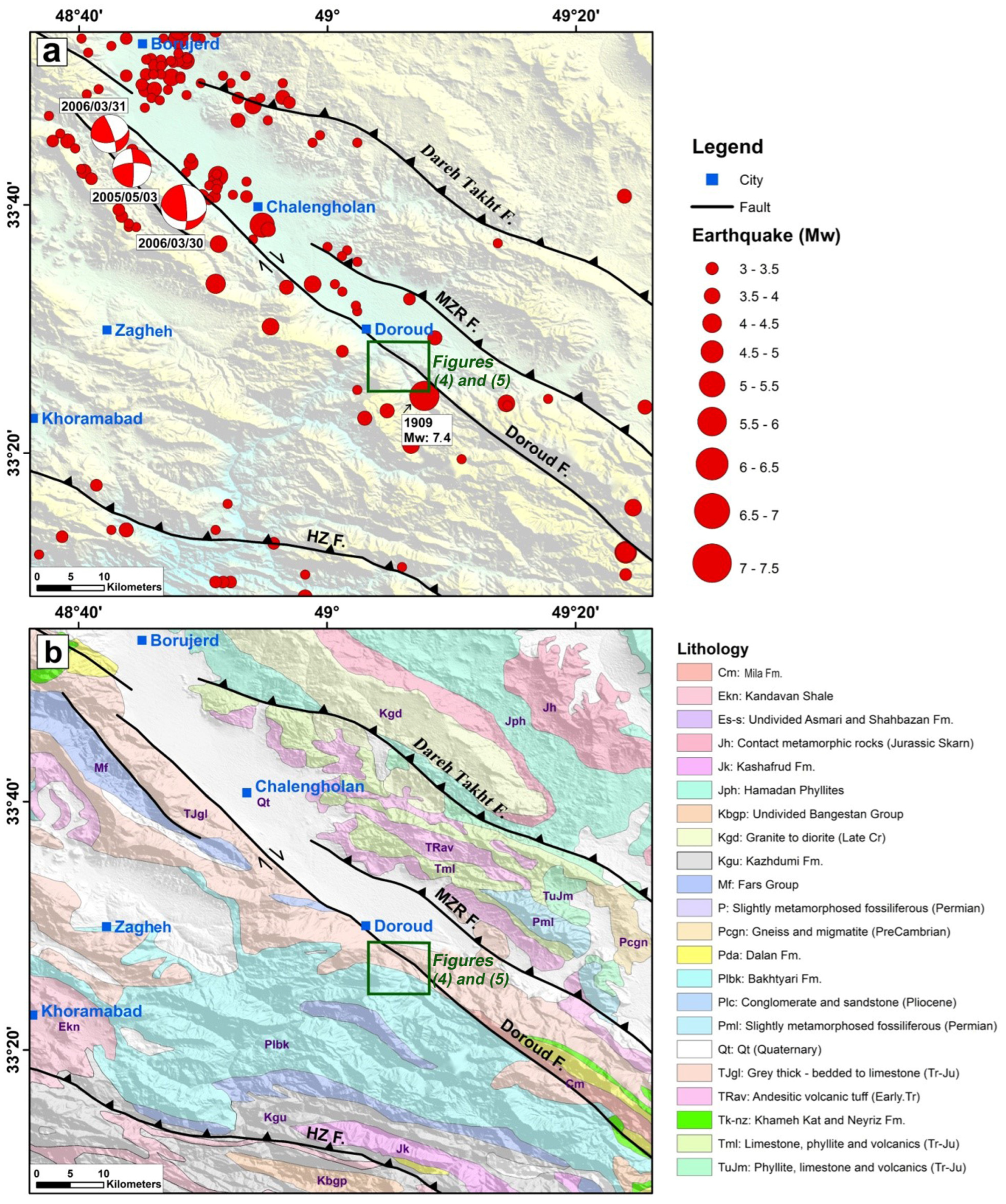

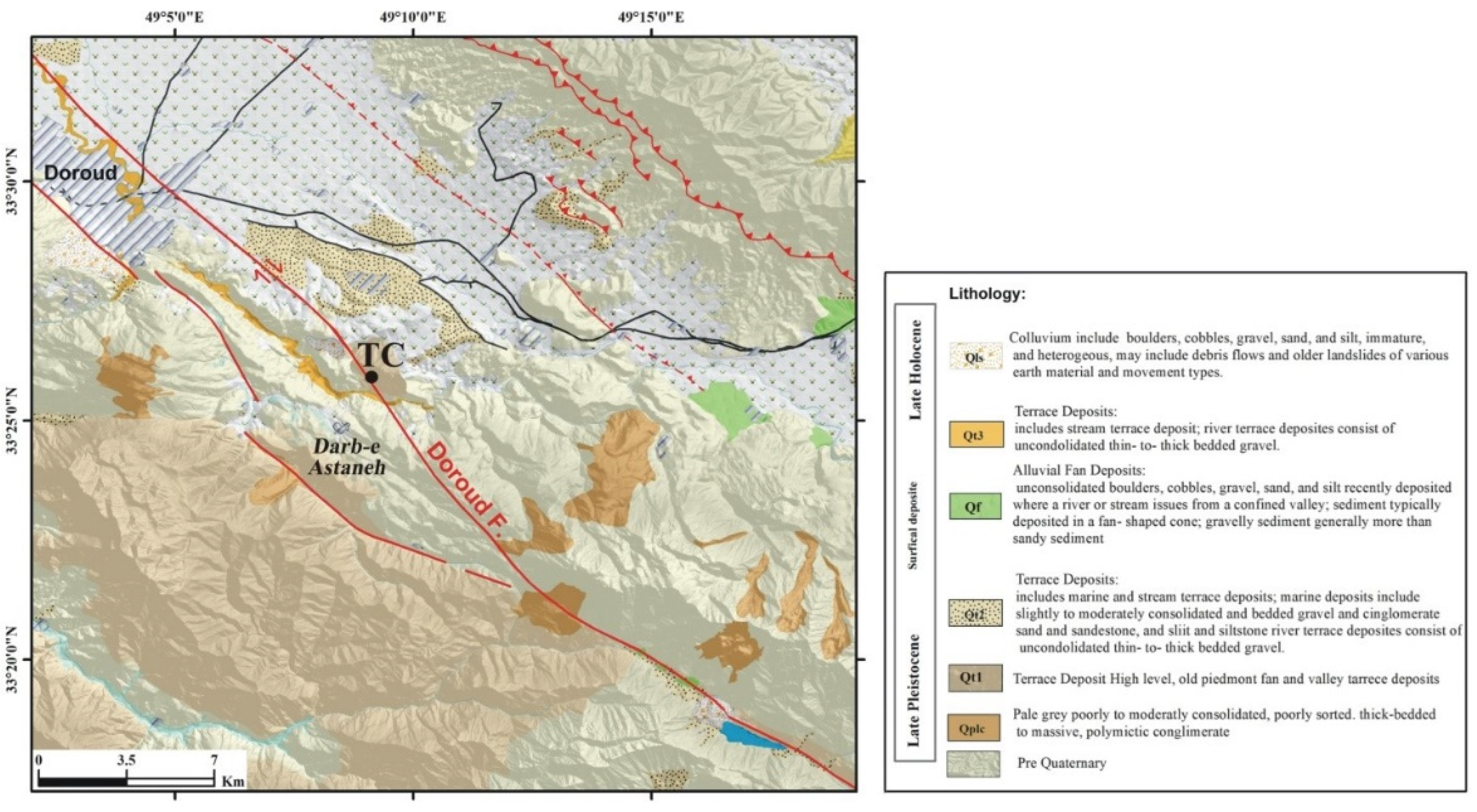
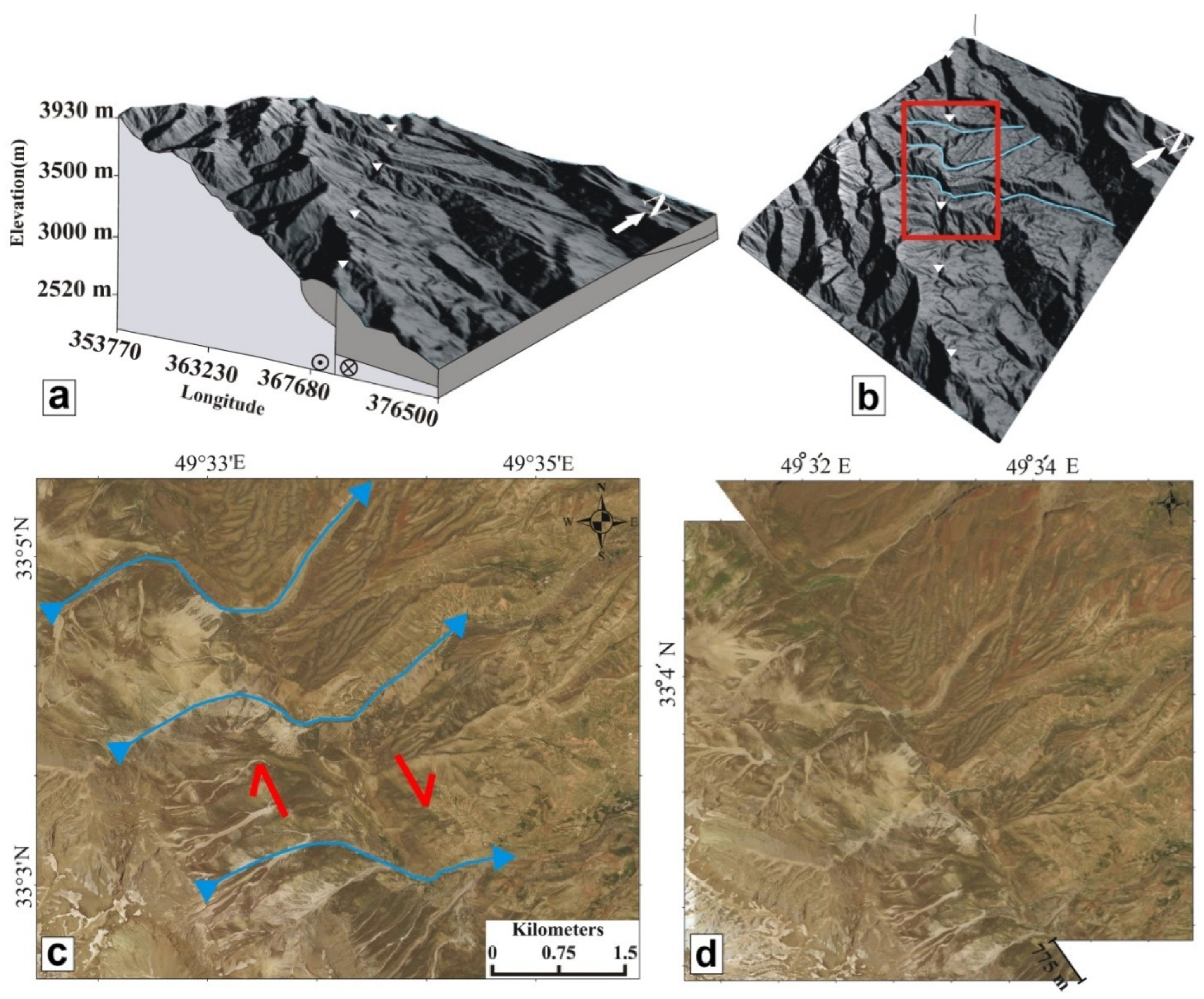
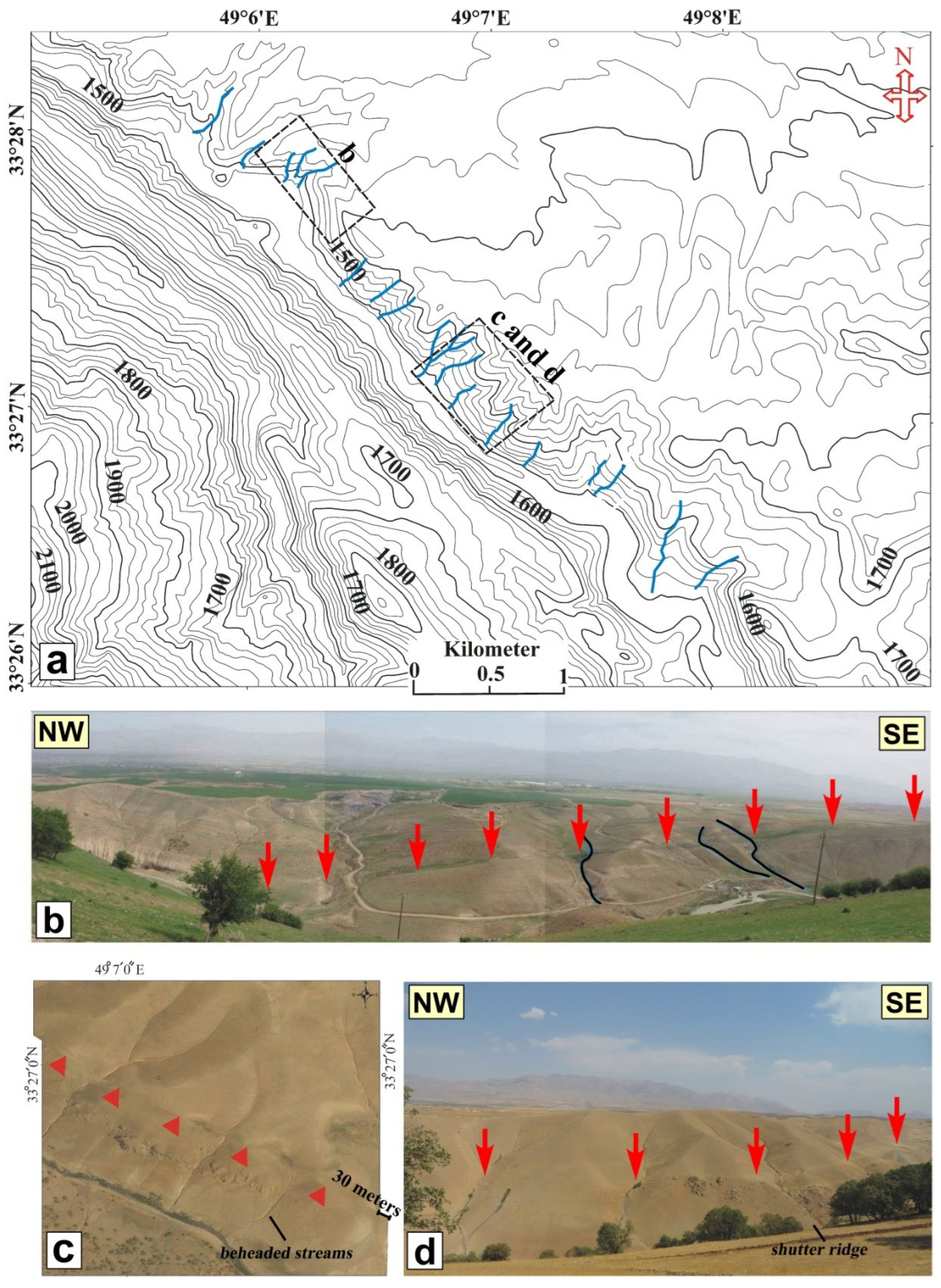
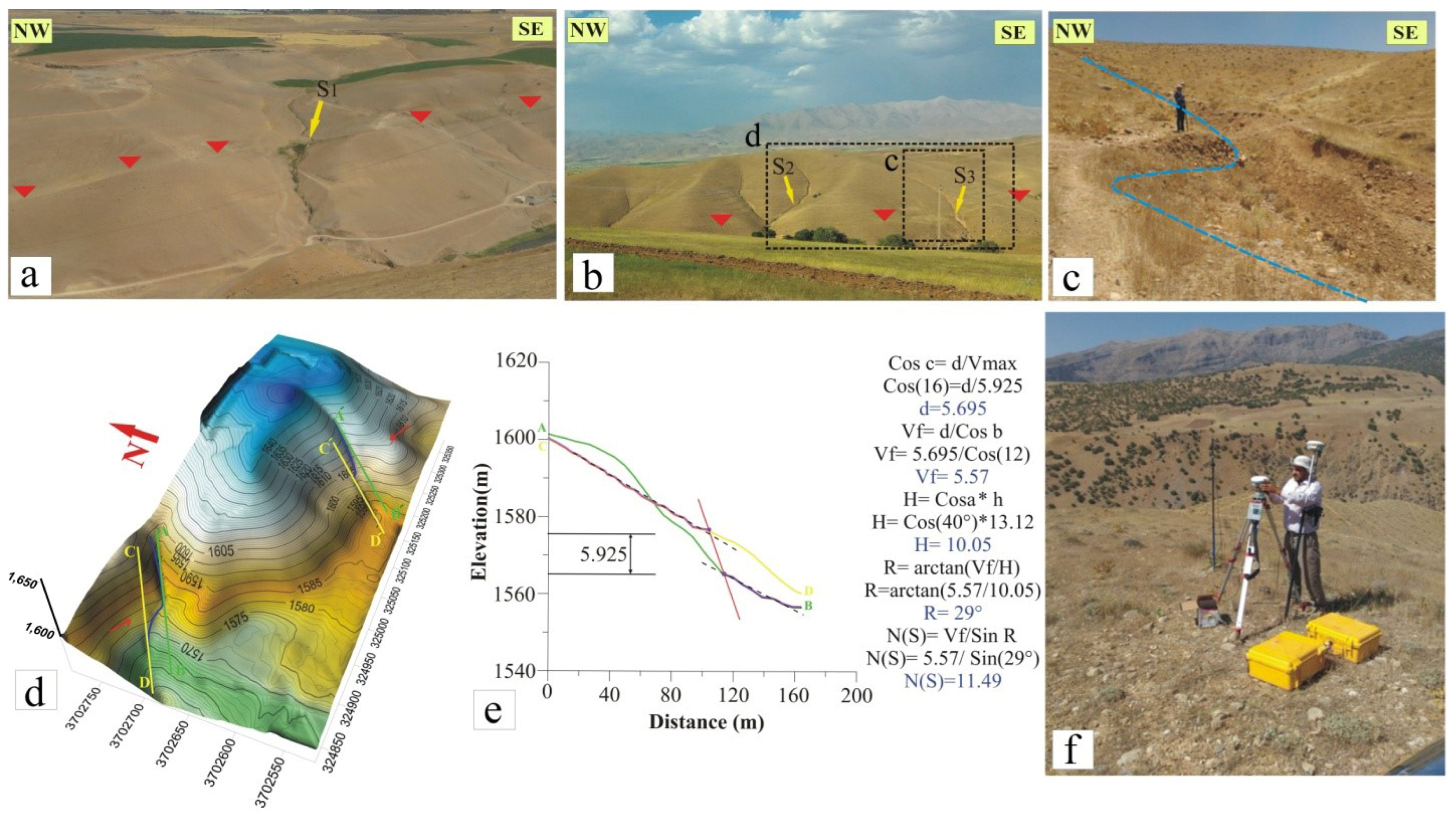

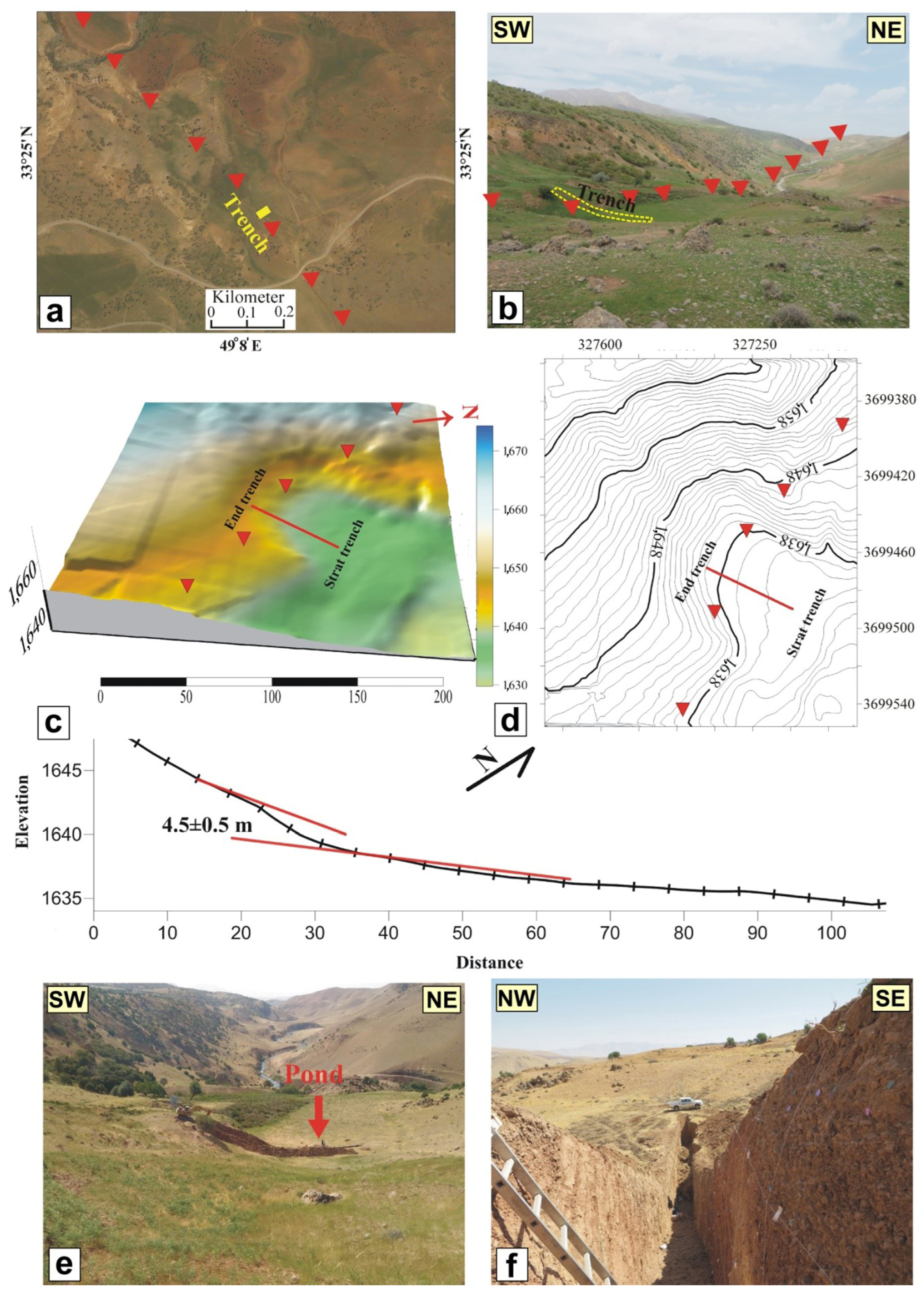
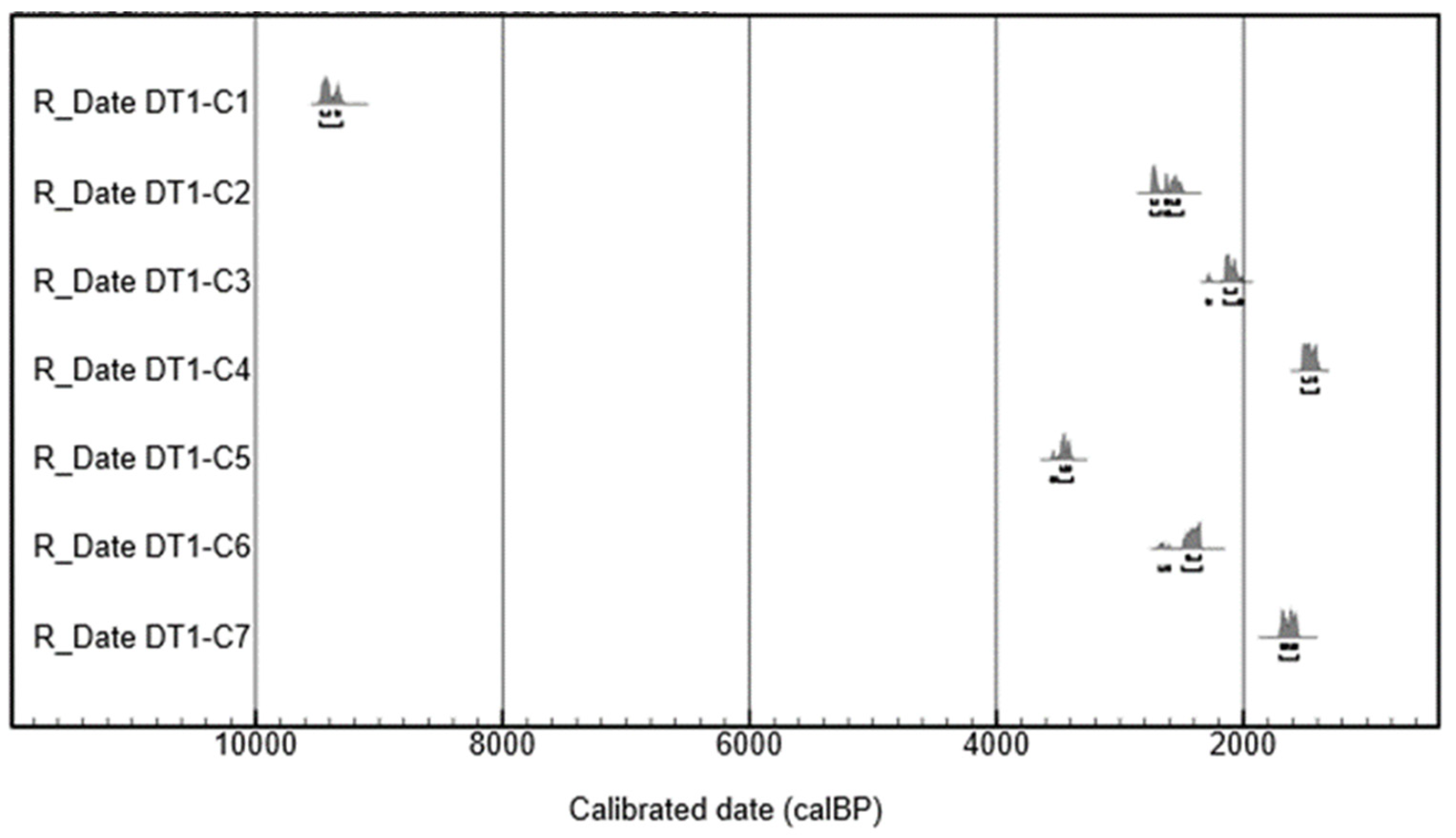




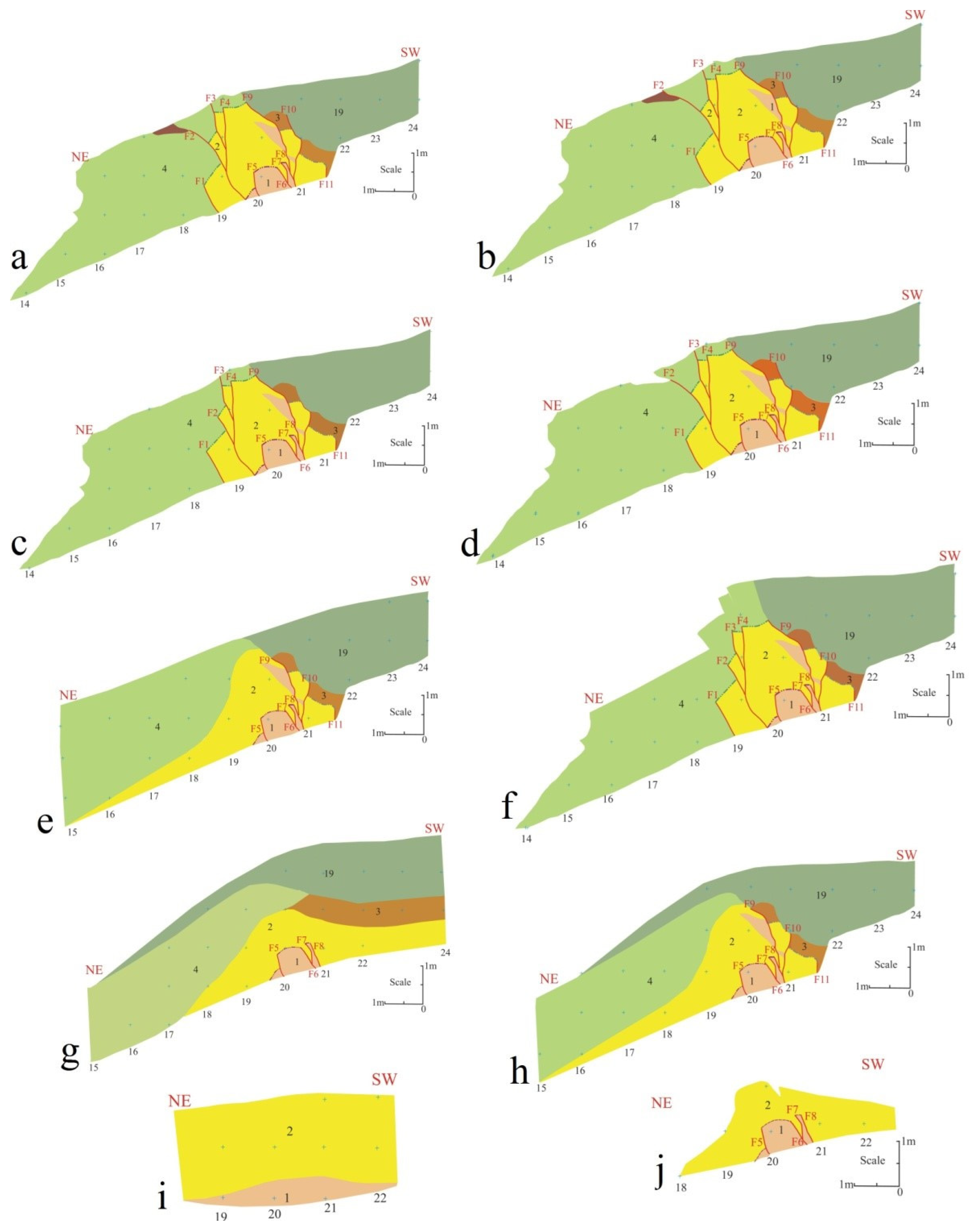
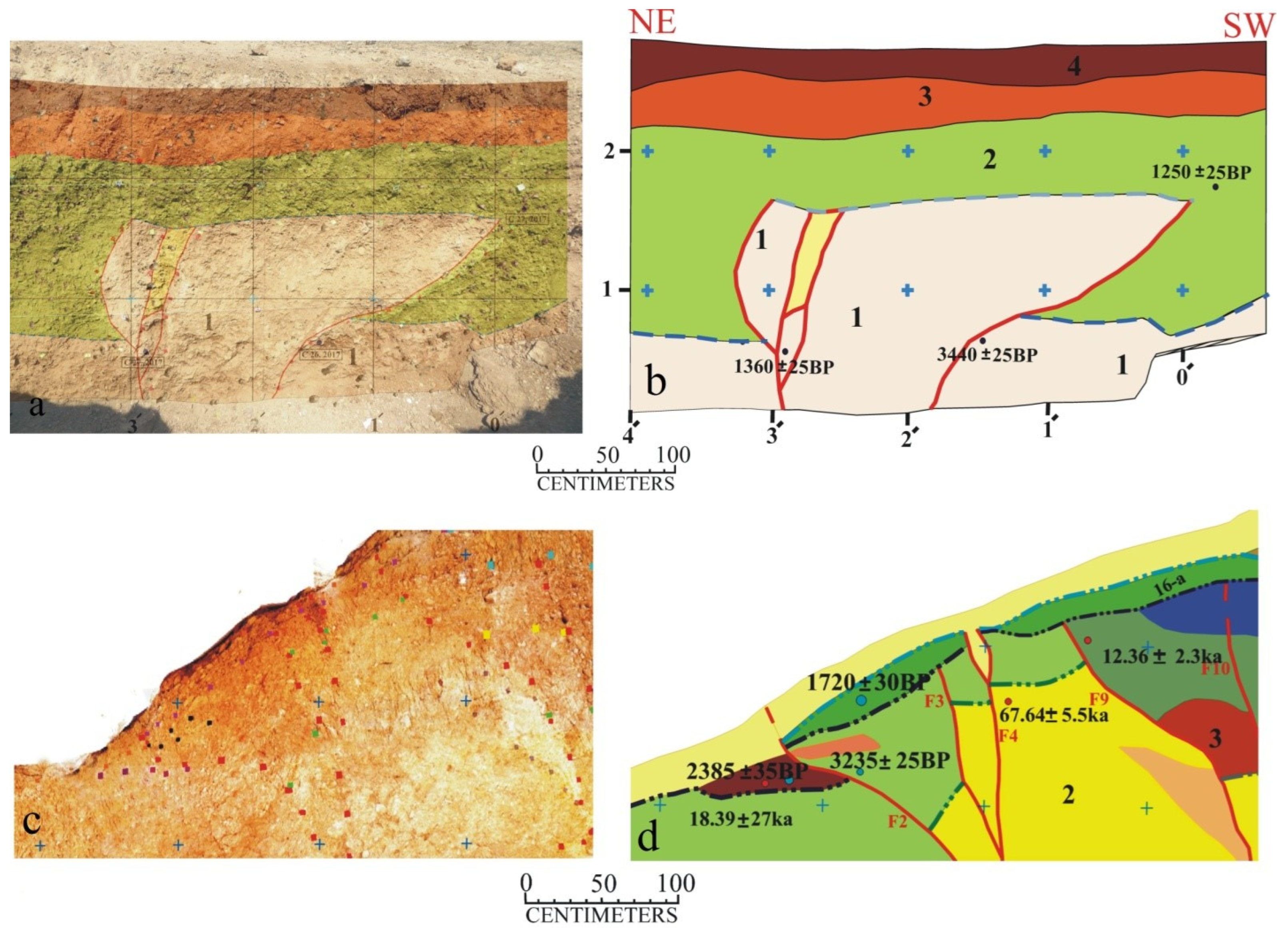
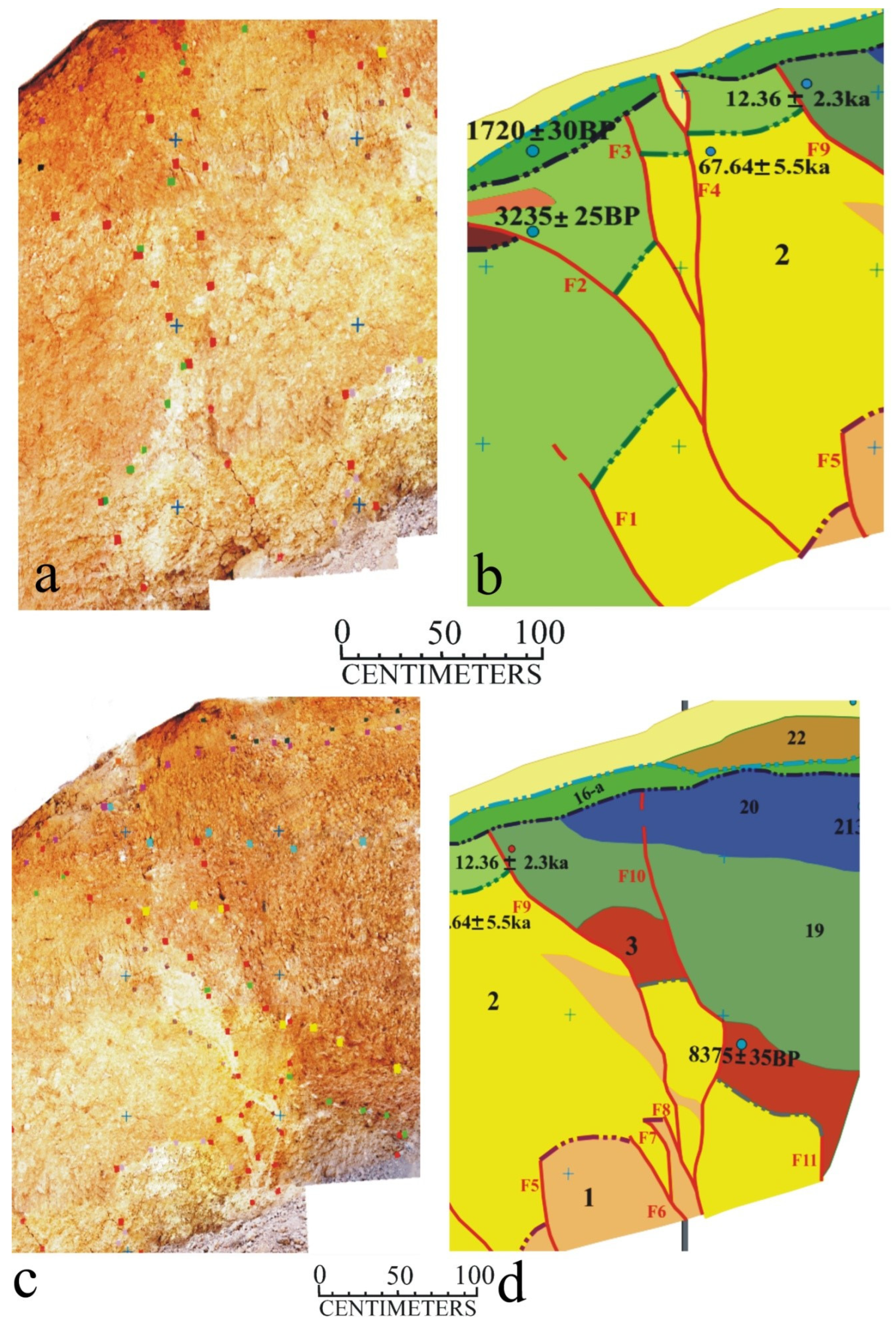


| Number | H (m) | Vmax (m) | Vf (m) | R (Radian) | NS (m) |
|---|---|---|---|---|---|
| 1 | 21.59 | 6.82 | 6.48 | 17 | 22.58 |
| 2 | 13.94 | 14.34 | 13.48 | 44 | 19.40 |
| 3 | 10.05 | 5.92 | 5.57 | 29 | 11.49 |
| Sample ID | De (Gy) | ± | Total (Gy/ka) | ± | Age (ka) |
|---|---|---|---|---|---|
| Dt1 Post IRSL river | 14.91042 | 2.74 | 3.23 | 0.08 | 4.61 |
| Dt1 IRSL 2 | 231.5025 | 16.55 | 3.48 | 0.09 | 66.62 |
| U Event | Age Cal BP | Event Horizon | Units | V (m) | H (m) | Ds (m) | Ss (m) | Net Slip (m) | MW (AD) SS | MW (MD) SS | MW (AD) N | MW (MD) N | MW (AD) G | L (Km) | F (Km) | A (Km2) | M0g (dyne cm) | MW |
|---|---|---|---|---|---|---|---|---|---|---|---|---|---|---|---|---|---|---|
| I’ | Before 1250–1360 | Base of Unit 2 | 2 | 3.83 ± 0.10 | 3.35 ± 0.1 | 1.76 ± 0.1 | 11.57 ± 0.1 | 3.83 ± 0.1 | 7.55 | 7.03 | 7.15 | 7.03 | 7.4 | 49 | 15 | 7.3512 | 1.3127 | 7.4 |
| II’ | Before 1360–3440 | Base of Unit 2 | 2 | Fissure size similar to Ev1′ | 3.35 ± 0.1 | 1.76 ± 0.1 | 11.57 ± 0.1 | 3.83 ± 0.1 | 7.55 | 7.03 | 7.15 | 7.03 | 7.4 | 49 | 15 | 7.3512 | 1.3127 | 7.4 |
| III | After 1560 | Base of Unit 22 | 22 | 0.093 ± 0.1 | 0.14 | 0.08 ± 1 | 0.02 ± 0.1 | 0.19 ± 0.1 | 6.4 | 6.03 | 6.31 | 6.22 | 6.33 | 49 | 15 | 7.3512 | 1.8125 | 6.1 |
| IV | Before 1560–1720 | Base of Unit 22 | 22 | Fissure size similar to Ev1 | 0.16 ± 0.1 | 0.08 ± 0.1 | 0.02 ± 0.1 | 0.19 ± 0.1 | 6.4 | 6.03 | 6.31 | 6.22 | 6.33 | 49 | 15 | 7.3512 | 1.8125 | 6.1 |
| V | Before 1720–2385 | Base of Unit 16-a | 16-a | 0.194 ± 0.10 | 0.34 ± 0.1 | 0.18 ± 0.1 | 0.12 ± 0.1 | 0.4 ± 0.1 | 6.68 | 6.26 | 6.5 | 6.39 | 6.6 | 49 | 15 | 7.3512 | 4.6325 | 6.6 |
| VI | Before 2385–3235 | Base of C1 | C1 | - | - | - | - | - | - | - | ? | ? | ? | ? | 15 | ? | ? | ? |
| VII | Before 3235–8375 | Base of Unit 4 | 4 | 1.04 ± 0.10 | 1.87 ± 0.1 | 0.98 ± 0.1 | 3.61 ± 0.1 | 2.14 ± 0.1 | 7.33 | 6.84 | 6.99 | 6.85 | 7.2 | 49 | 15 | 7.3512 | 1.3127 | 7.2 |
| VIII | Before8375–66620 | Base of Unit 3 | 3 | 0.63 ± 0.10 | 1.13 ± 0.1 | 0.59 ± 0.1 | 1.31 | 1.29 ± 0.1 | 7.13 | 6.68 | 6.85 | 6.71 | 7.02 | 49 | 15 | 7.3512 | 3.1626 | 7 |
| IX | Before 66620 | Base of Unit 2 | 2 | 0.5 ± 0.10 | 0.9 ± 0.1 | 0.47 ± 0.1 | 0.84 ± 0.1 | 1.03 ± 0.1 | 7.05 | 6.6 | 6.78 | 6.59 | 6.94 | 49 | 15 | 7.3512 | 2.1226 | 6.9 |
| Event | Mw | AD (m) [59,60,61,62] | SRL (km) | RLD (km) | RW (km) | RA (km2) | U (m) |
|---|---|---|---|---|---|---|---|
| I’, II’ | 7.4 | 2.35 | 70.79 ± 0.21 | 95 ± 0.7 | 29.5 ± 0.35 | 2137 ± 10 | 0.74 |
| III, IV | 6.1 | 0.089 | 12.88 ± 0.21 | 14 ± 0.7 | 7.9 ± 0.35 | 117 ± 10 | 0.71 |
| V, VI | 6.6 | 0.19 | 19.49 ± 0.21 | 22 ± 0.7 | 10.96 ± 0.35 | 234 ± 10 | 0.72 |
| VII | 7.2 | 1.65 | 61.65 ± 0.21 | 81 ± 0.7 | 25.7 ± 0.35 | 1479 ± 10 | 0.74 |
| VIII | 7 | 0.81 | 41.68 ± 0.21 | 53 ± 0.7 | 19.05 ± 0.35 | 870 ± 10 | 0.73 |
| IX | 6.9 | 0.54 | 33.88 ± 0.21 | 41 ± 0.7 | 16.21 ± 0.35 | 602 ± 10 | 0.73 |
| Mw | Time | Number |
|---|---|---|
| 6.1 | 2006.03.31 | 1 |
| 7.4 | 1909.01.23 | 2 |
| 7.4 | 740 ± 37 AD | 3 |
| 7.4 | 654 ± 9 AD | 4 |
| 6.1 | 488 ± 42 AD | 5 |
| 6.6 | 488 < EQ < 3158 AD | 6 |
| - | 1497 ± 28 < EQ < 470 ± 53 BC | 7 |
| 7.2 | 7448 ± 57 BC < EQ < 1497 ± 28 BC | 8 |
| 7 | EQ > 7448 ± 57 BC | 9 |
| ? | EQ > 16019 BC | 10 |
| ? | 20186 < EQ < 16019 BC | 11 |
| 6.8 | EQ > 66620 BC | 12 |
Disclaimer/Publisher’s Note: The statements, opinions and data contained in all publications are solely those of the individual author(s) and contributor(s) and not of MDPI and/or the editor(s). MDPI and/or the editor(s) disclaim responsibility for any injury to people or property resulting from any ideas, methods, instructions or products referred to in the content. |
© 2023 by the authors. Licensee MDPI, Basel, Switzerland. This article is an open access article distributed under the terms and conditions of the Creative Commons Attribution (CC BY) license (https://creativecommons.org/licenses/by/4.0/).
Share and Cite
Kamali, Z.; Nazari, H.; Rashidi, A.; Heyhat, M.R.; Khatib, M.M.; Derakhshani, R. Seismotectonics, Geomorphology and Paleoseismology of the Doroud Fault, a Source of Seismic Hazard in Zagros. Appl. Sci. 2023, 13, 3747. https://doi.org/10.3390/app13063747
Kamali Z, Nazari H, Rashidi A, Heyhat MR, Khatib MM, Derakhshani R. Seismotectonics, Geomorphology and Paleoseismology of the Doroud Fault, a Source of Seismic Hazard in Zagros. Applied Sciences. 2023; 13(6):3747. https://doi.org/10.3390/app13063747
Chicago/Turabian StyleKamali, Zahra, Hamid Nazari, Ahmad Rashidi, Mahmoud Reza Heyhat, Mohammad Mahdi Khatib, and Reza Derakhshani. 2023. "Seismotectonics, Geomorphology and Paleoseismology of the Doroud Fault, a Source of Seismic Hazard in Zagros" Applied Sciences 13, no. 6: 3747. https://doi.org/10.3390/app13063747
APA StyleKamali, Z., Nazari, H., Rashidi, A., Heyhat, M. R., Khatib, M. M., & Derakhshani, R. (2023). Seismotectonics, Geomorphology and Paleoseismology of the Doroud Fault, a Source of Seismic Hazard in Zagros. Applied Sciences, 13(6), 3747. https://doi.org/10.3390/app13063747







